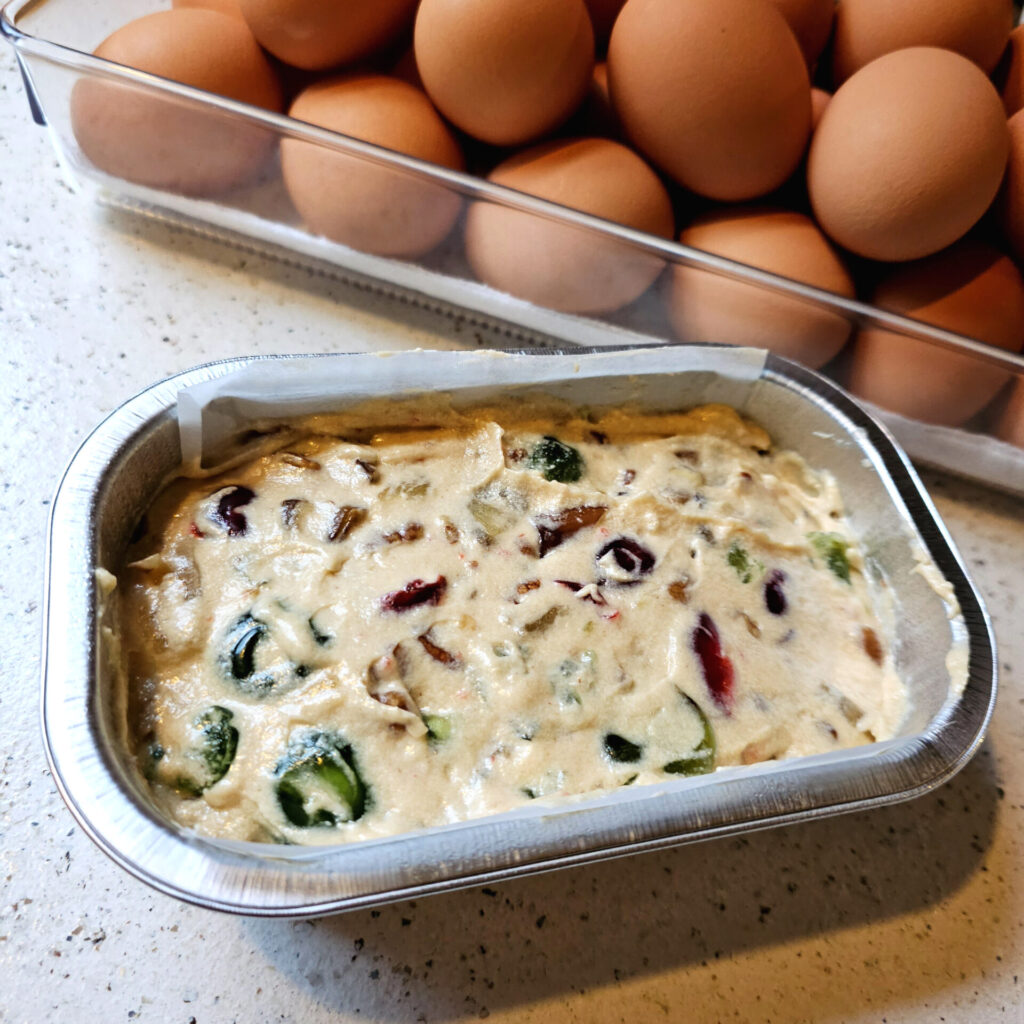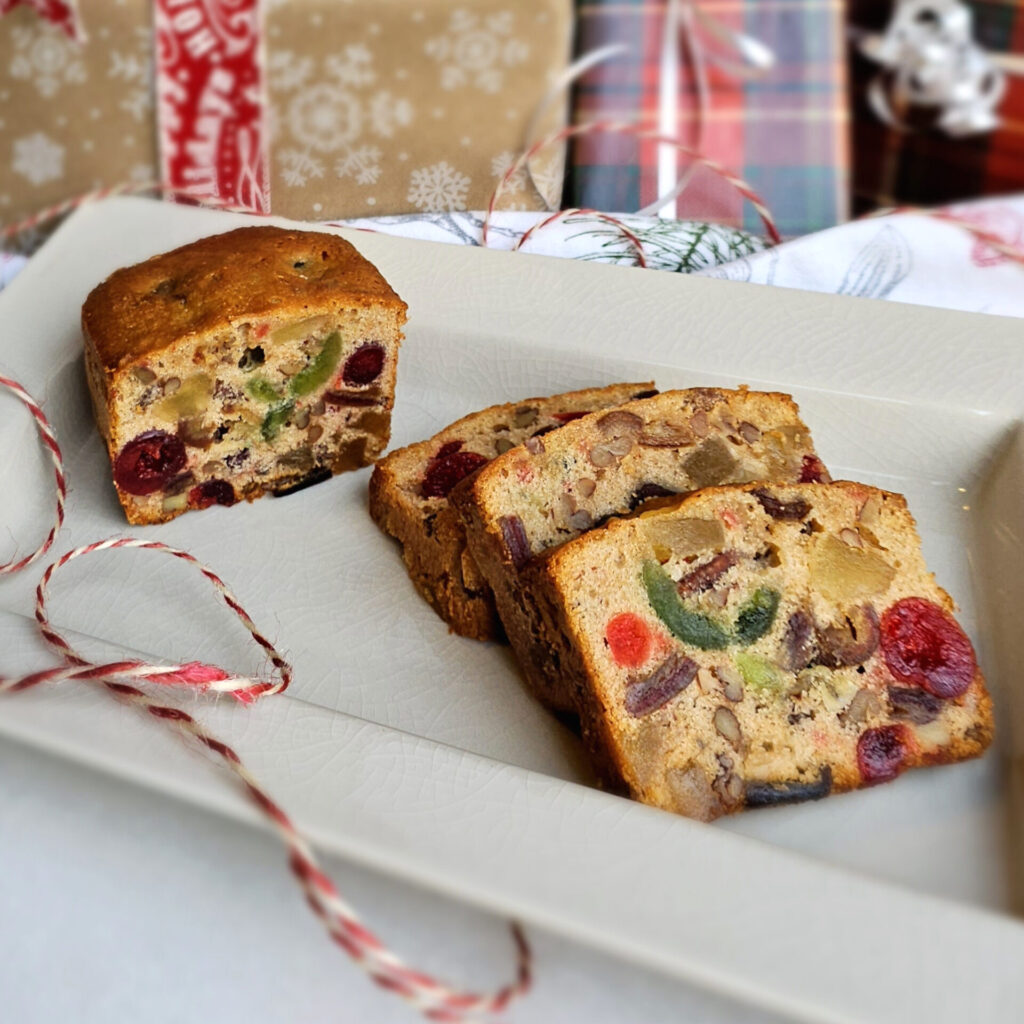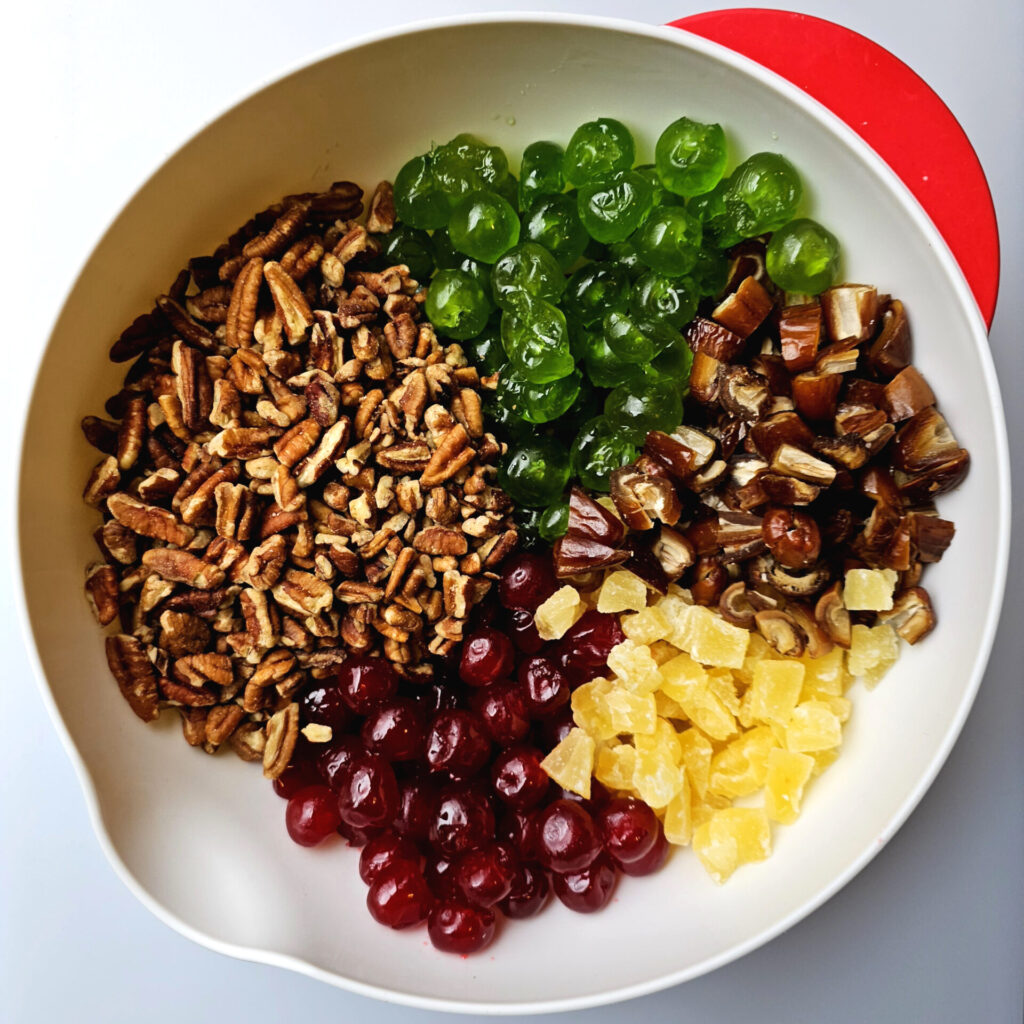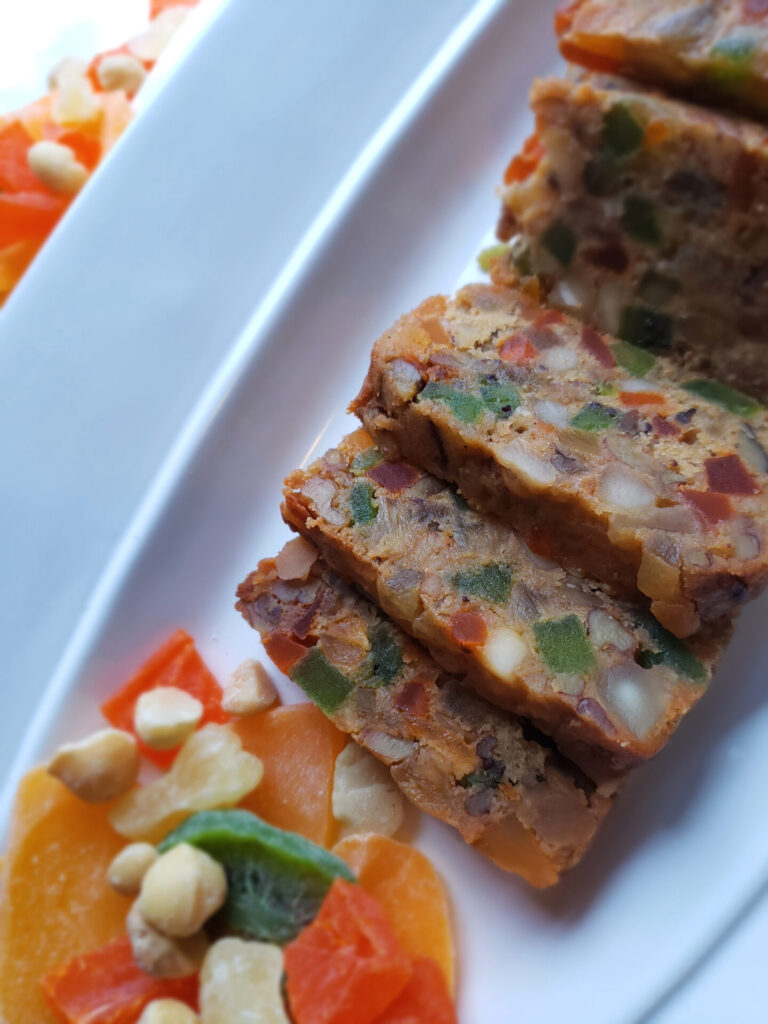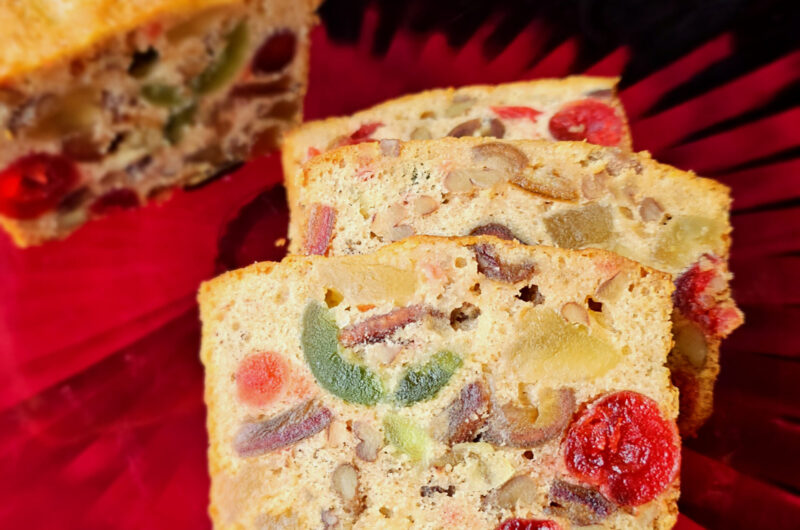I’m on a mission to convert as many fruitcake haters as possible with this Festive 5 Star Amaretto Fruitcake recipe. Packed with cherries, dates, candied pineapple and pecans, this delightful, holiday dessert is finished in a blend of Amaretto and golden rum.
Fruitcake. Where do I even begin. This dense and flavorful dessert, adorned with candied fruits, nuts, and often soaked in spirits, has enchanted palates, sparked lighthearted humor, and possibly even broken up a friendship or two through the re-gifting of a really bad, boozy brick. But I’m telling you a really good fruitcake is not a myth, and once you’ve had one, your Christmas holiday won’t be complete until you’ve enjoyed a slice or two around the tree.
In this post, we’ll delve into the history of fruitcake, its enduring presence in American traditions, and the spirited alchemy that brings this classic treat to life.
Jump to RecipeTable of Contents
Origins of the Jewel Studded Holiday Treat
The history of the fruitcake is as rich and dense as the jewel studded dessert itself. Originating in ancient Rome, where a mixture of pomegranate seeds, pine nuts, and barley mash was concocted, the concept of a fruit and nut cake evolved over time. In the Middle Ages, honey and spices were introduced, and with the Crusaders’ return, new exotic fruits like citron and dates found their way into the recipe. As trade routes expanded, so did the variety of ingredients, making fruitcake a symbol of prosperity and celebration during holidays and special occasions. The Victorian era further popularized fruitcake, with its association with Christmas festivities.
Despite the cake’s enduring popularity, it has faced its share of unfortunate jokes and stereotypes. It’s often portrayed as a gift that gets passed around without being eaten or as a doorstop due to its perceived density. This playful mockery has led to a somewhat divided opinion about fruitcake. Some people genuinely enjoy the taste and tradition, while others may approach it with skepticism. I tend to believe if you like fruitcake, you’ve experienced a good one.
For those fruitcake skeptics, I concede there are a lot of really bad fruitcakes in circulation during the holidays. The quality of the fruit is poor, the booze is the kind found two levels below the bottom shelf and is so heavy, I’d be afraid to drive afterwards for fear of blowing positive if pulled over. It’s no wonder fruitcakes have become the subject of such scathing humor.
Traditionally, fruitcake has been a part of American holiday celebrations, especially during Christmas. Its rich and flavorful profile, often soaked in alcohol, aligns well with the festive spirit. The cake’s association with the holiday season can be traced back to European traditions, which were brought to America by early settlers. In recent years, there has been a resurgence of interest in traditional and homemade foods and food gifts – including fruitcake. Many bakers and food enthusiasts appreciate the craftsmanship and unique flavors that come with a well-prepared cake. Additionally, creative variations and modern recipes have emerged, adapting this classic dessert to suit contemporary tastes.
Spirits Often Used in this Classic Holiday Dessert
A variety of spirits are commonly used in fruitcakes to enhance their flavor and contribute to the overall richness of the dessert. The choice of spirits often depends on personal preference and regional traditions. Some of the most popular spirits used in fruitcakes include:
- Brandy: Perhaps the most classic choice, brandy is often used to soak dried fruits and nuts before incorporating them into the fruitcake. Brandy adds a warm and complex flavor, and its alcohol content helps preserve the cake.
- Rum: Dark rum is another common choice, especially in Caribbean and tropical variations. The robust and slightly sweet flavor of rum complements the fruits and spices in the cake.
- Whiskey: Bourbon or other types of whiskey can be used to add a smoky and caramel-like note to this classic holiday dessert. Whiskey pairs well with the sweetness of the dried fruits.
- Sherry: Sherry, a fortified wine, can impart a nutty and slightly sweet flavor to the fruitcake. It is often used in lighter fruitcakes or variations that aim for a more delicate taste.
- Red Wine: Some recipes incorporate red wine, particularly in combination with brandy or other spirits, to add depth and complexity to the flavor profile.
- Fruit Liqueurs: Liqueurs such as Grand Marnier, Cointreau, or even fruit-flavored liqueurs can be used to infuse a specific fruitiness into the cake.
The choice of spirit can greatly influence the final taste of the cake, and many recipes call for a period of soaking the dried fruits in the chosen spirit to allow them to absorb the flavors before baking. Additionally, some bakers also choose to periodically brush the finished fruitcake with more spirits after baking to keep it moist and intensify the flavor.
In this recipe, I chose a two-tiered approach to infusing flavor into the fruitcake. We start by soaking the fruit and pecans in a mixture of rum and amaretto. I prefer Old Monk Rum for this bake. It plays beautifully with the Amaretto, but you can also use Captain Morgan Original and get a similar result. As with most of my recipes, I recommend using a good mid-range rum for this bake. No need to pull your unopened bottle of Dagger Rum for use here. Save that for your kid’s college fund.
Once the cakes have finished baking and while they are still warm, we baste them again in a blend of amaretto and rum and allow it to soak through the beautiful loaves. This ensures the flavors of the rum and amaretto penetrate through the entire cake.
Patience Pays Off in the End
I encourage you to be patient with this bake. Something magical happens the longer it sits. The flavor and texture improve. The spirits mellow, and the color of the fruit becomes like wet beach glass.
If you want to keep with tradition, but still explore something new, I’d also like to encourage you to give this recipe for Tropical Fruit Cake a try. You may just discover a new favorite. Best Tropical Fruit Cake is a rum-infused twist on a holiday classic that’s packed with candied tropical fruit and macadamia nuts. In place of candied citrus and cherries often found in a traditional fruit cake, you’ll find dried pineapple, kiwi, mango, papaya and coconut in this version. Dry roasted and salted Macadamia nuts are blended with walnuts for a unique texture and flavor. And the salt from the macadamia nuts helps to balance the sweetness of this cake. And then there’s the rum!
Festive 5 Star Amaretto Fruitcake – The Resurgence of a Classic
Whether you’re drawn to the classic allure of brandy-soaked fruits or inclined to experiment with modern variations like my recipe for Tropical Fruitcake or this interpretation of a classic, the spirit of fruitcake continues to thrive. I hope you embrace the joy of baking this unique dessert, savor its rich history, and perhaps challenge the stereotypes that have haunted this festive treat with humor. From its ancient origins to the diverse renditions we find today, the fruitcake invites us to savor not only its flavors but also the stories it carries through the ages. I hope you give this recipe a try, and may it fill your holiday with warmth and happiness.
Festive 5 Star Amaretto Fruitcake
Course: DessertCuisine: AmericanDifficulty: Intermediate4
cakes40
minutes50
minutesThis recipe yields four 5″x3″x2″ mini loaves. Loaves will bake for approximately 50 minutes.
Ingredients
- For the batter
1 cup (2 sticks) unsalted butter
1 cup granulated sugar
5 large eggs, room temperature
11/3 cups A.P. Flour1 tsp. baking powder
1 tsp. salt
- For the fruit
1/4 cup golden rum
1/4 cup Amaretto
2 cups pecans, roughly 1/4 inch diced
2 cups dates, roughly 1/4 inch diced
1 cup dried, candied pineapple, 1/4 inch diced
8 ounces candied red cherries
8 ounces candied green cherries
- For brushing the fruitcakes after baking
An additional 1/4 cup golden rum
An additional 1/4 cup Amaretto
Directions
- Preheat oven to 300 degrees F. Line loaf pans with either baking cups or slips of parchment paper for easier removal. Set aside. If using baking containers designed for sharing, you can skip this step. See notes section on quantities.
- Prepare the fruit
- In a large glass or stainless steel bowl, mix together the chopped fruit and nuts.
- Blend together the rums. Pour over the fruit and nut mixture and let stand for 30 minutes. This gives the fruit time to absorb the liquid.
- Prepare the cake batter
- Cream together the butter and sugar until light and fluffy.
- Add the vanilla and the eggs, one at a time. Scrape down the sides of the bowl between additions.
- Sift the flour, baking powder and salt into the butter mixture and blend thoroughly.
- After the fruit has rested for 30 minutes, add it to the batter. Mix the batter until all the fruit is evenly incorporated. You may need to use a spatula to finish mixing.
- Spoon the batter into the prepared baking pans and level the tops of the batter with a small spatula or the back of a spoon.
- Bake at 300 degrees F. until a toothpick inserted in the middle of the loaf comes out clean. For small loaves, this will be roughly 50 minutes. Individual ovens vary, so adjust baking time as needed.
- Brush the cakes with the Amaretto and rum
- After removing the cakes from the oven, and while the cakes are still warm, brush them lightly with an additional 1/2 cup of Amaretto and rum. Rotate through all the cakes until all the spirits are used. Allow the cakes to finish cooling to room temperature. Wrap fruitcakes in plastic wrap individually and store in an airtight container for two days before slicing.
Notes
- Why do I need to let the cakes rest for two days before cutting? Trust me, your patience will be rewarded. The texture of this cake actually improves the longer it sits. The moisture from the fruit and the spirits creates the beautiful, smooth texture of this cake as everything marries. The flavor of the spirits mellows, the color of the fruit becomes like wet beach glass and the cake becomes so easy to cut. You can cut into the cake immediately, but it will crumble and the booze flavor will be too forward – working against the flavors in the cake, instead of with them.
- Can I use a food processor to chop the fruit and nuts? I do not recommend using a food processor for this recipe. The candied fruit is sticky and can gum up the blade, without giving you an even dice on the fruit. Better to chop by hand.


